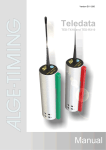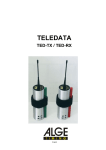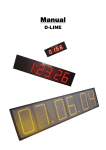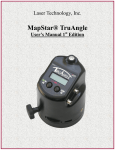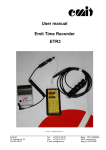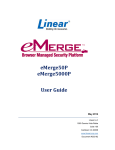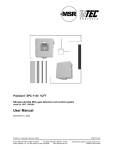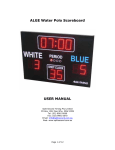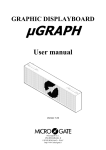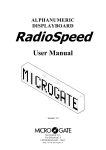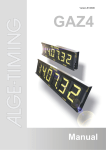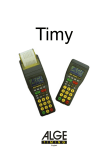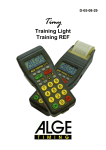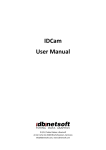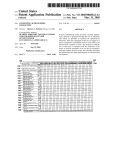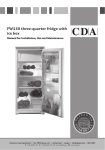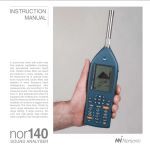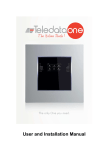Download Manuel TED 400 mw EN
Transcript
Version-E080421 Manual TED-TX / RX Seite 2 1 2 3 4 5 6 7 8 9 10 11 12 13 14 15 antenna green holder with velcro fastener light-emitting diode banana plug yellow, data input banana plug green, signal input banana plug black, shared ground (compound) DIN-plug: data and signal input as well as external feed 3/8 thread measured in inches, for tripod fastening code-switcher (16 positions) device-button device-switcher code-switcher (10 positions) fastening screw for battery-cover battery-cover type shield with device number 1 2 3 4 5 6 7 8 9 10 11 12 13 14 15 antenna red holder with velcro fastener light-emitting diode banana plug yellow, data output banana plug green, signal output banana plug black, shared ground (compound) DIN-plug: data and signal output as well as external feed 3/8 thread measured in inches, for tripod fastening code-switcher (16 positions) device-button device-switcher code-switcher (10 positions) fastening screw for battery cover battery cover type shield with device number TED-TX / RX Table of content 1 2 2.1 2.2 2.2.1 2.2.2 2.3 2.3.1 2.3.2 2.4 2.4.1 2.4.2 3 3.1 3.2 3.3 3.4 3.5 3.6 4 4.1 4.2 4.3 4.4 4.5 5 5.1 5.1.1 5.1.2 5.2 5.2.1 5.2.2 5.2.3 5.2.4 5.3 6 General ....................................................................................................................................... 4 Power supply ............................................................................................................................. 5 Battery exchange......................................................................................................................... 5 Operation with Alkaline batteries ................................................................................................. 6 Battery warning........................................................................................................................ 6 Operation time ......................................................................................................................... 6 Operation with NiCd-accus.......................................................................................................... 7 Accu warning ........................................................................................................................... 7 Operation time ......................................................................................................................... 7 External supply ............................................................................................................................ 8 Direct supply ............................................................................................................................ 8 Supply by the timing device..................................................................................................... 8 Implementation .......................................................................................................................... 9 Installation.................................................................................................................................... 9 Switch-on ................................................................................................................................... 10 Choice of operation mode ......................................................................................................... 11 Addressing................................................................................................................................. 12 Field strength test for site selection........................................................................................... 13 Annoyance test – tapping of the receiver for disturbing signals................................................ 14 Impulse transmission.............................................................................................................. 15 Impulse transmission of a startgate........................................................................................... 16 Impulse transmission of a photocell .......................................................................................... 16 Impulse transmission RLS with adapter 129-06........................................................................ 17 Impulse transmission with more than 2 timing channels ........................................................... 17 Impulse transmission of more timing channels with Timy and cable 207-10 ............................ 19 Data transmission ................................................................................................................... 20 Data transmission 1 second ...................................................................................................... 21 Data transmission from Timer S4 to Timer S4 ...................................................................... 21 Data transmission from ALGE timing device to printer P4A.................................................. 22 Data transmission 0,1 seconds ................................................................................................. 23 Data transmission to ALGE displayboard.............................................................................. 23 Data transmission from Comet to ALGE soccer displayboard .............................................. 23 Data transmission from a ALGE timing device to Comet Parallel display............................. 24 Data transmission from ALGE timing device to PC............................................................... 24 Data transmission directly ......................................................................................................... 24 Technical data.......................................................................................................................... 25 Subject to technical alterations in terms of improvement! Download the latest manual for free on our homepage http://www.alge-timing.com/. TED manual copyright by: ALGE-TIMING Rotkreuzstraße 39 A-6890 Lustenau Seite 3 TED-TX / RX 1 General Purpose: Wireless transfer of timing impulses or data Transfer frequency : in 70cm band TED-TX10: Teledata transmitter with an output performance of 10mW appr. 1,5 km range, l/4 antenna TED-RX10: Teledata receiver to TED-TX10 with l/4 antenna TED-TX400: Teledata transmitter with an output performance of 400mW appr. 5 km range, BNC antenna TED-RX400: Teledata receiver to TED-TX400 with BNC antenna Minimal equipment components: 1x TED-TX and 1x TED-RX Expanded Accessories: added TED-TX for impulse and data transfer, added TED-RX for data transfer RX-C10 for impulse transfer if you use more than two timing channels Cognition feature for TED-TX: type shield (15) and green holder (2) Cognition feature for TED-RX: type shield (15) and red holder (2) Indication on type shield: device type device number Impulse transfer: The impulse transfer works directly from a ALGE-emitter to the ALGE timing device. Data transfer ALGE "1 Sec.": Every data set will be transfered 10 times out of safety reasons. Onedata set per second will be transfered. Data transfer ALGE "0,1 Sec": Every data set will be transfered once. One data set per 0,1 seconds will be transfered. Data transfer 2400 Baud: Every data set will be transfered once with 2400 Baud. At the beginning as well as at the end of each data set you have to indicate an identifier in order to start and to stop the data transfer. Data transfer 4800 Baud: Every data set will be transfered once with 4800 Baud. At the beginning as well as at the end of each data set you have to indicate an identifier in order to start and to stop the data transfer. Data transfer directly: All data will be transfered, the transmitter (TEDTX) is always on. Seite 4 TED-TX / RX System test: Field strength test Annoyance test Power supply: with 6 batteries or with 6 NiCd-accus or with external supply Radio permission: The permission regulations in Europe variies from country to country. For some countries you have to apply for a permission for our TED-TX400. If you need any information concerning this matter , please get in contact with your ALGE representative. 2 Power supply There are two types of power supply: Internal power supply with six batteries (Mignon) or accus (Typ AA) External power supply with ALGE power supply unit, via timing device or a 12V battery. 2.1 Battery exchange You can reach the battery cover at the lower side of the TED´s. The knurled screw must be unscrewed anticlockwise. Remove the cover. Remove the batteries (put up the device in order that the batteries will slip out.) Set in the new (or loaded) battery. (Notice the polarity, see battery cover) Put on the cover and screw the knurled screw. The screw must be screwed to the stop position. Seite 5 TED-TX / RX 2.2 Operation with Alkaline batteries Every TED requires 6 Alkaline batteries (Type AA). The battery status will be shown during the normal operation with help of the diodes. Color of diode (3) green border between green and orange orange border between orange and red red out Battery capacity 35-100 % ca. 35 % 20 to 35 % ca. 20 % less than 20 % empty The TED switches-off automatically, if the battery tension is below 5 Volt! ATTENTION: The light-emitting diode has an other function during the field strength test! (see point 3.5) 2.2.1 Battery warning If the battery has less than 20% capacity (LED red) then the TED-TX will transfer this information the the TED-RX together with the next data set or information. He will switch-on the internal loudspeaker, after that you can hear alternately a high-pitched and a low tone. The TED-RX will always activiate the internal loudspeaker as soon as the battery capacity is below 20%. 2.2.2 Operation time The above indicated measurings refer to Alkaline batteries (Type Energizer) at room temperatures (25°C). Please pay attention to the fact, that the battery capacity will be extremely reduced at low temperatures. (at –20°C approx. just 20% capacity). TED-TX10 TED-TX10 TED-TX10 TED-TX10 TED-TX400 TED-TX400 TED-TX400 TED-TX400 TED-RX Seite 6 without photocell with photocell ----without photocell with potocell ------- 1 impulse per minute 1 impulse per minute 1 data set per minute always sends data 1 impulse per minute 1 impulse per minute 1 data set per minute always sends data the same in all operation modes approx. 300 hours approx. 66 hours approx. 270 hours approx. 54 hours approx. 270 hours approx. 60 hours approx. 54 hours approx. 6 hours approx. 54 hours TED-TX / RX 2.3 Operation with NiCd-accus Every TED requires 6 NiCd-accus (Typ AA).The accus cannot be loaded in the device. In order to load you will need a separately loading station. The accu sitution (accu capacity) will be shown during the normal operation with help of the light-emitting diodes (3). Color of diode (3) green border between green and orange orange border between orange and red red out Battery capacity 15 to 100 % approx. 15 % 5 to 15 % approx. 5 % less than 5 % empty The TED switches automatically off, if the battery pressure goes below 5 Volt! Attention: The light-emitting diode has an other function during the field strength test! (see point 3.5) 2.3.1 Accu warning The same as Alkaline batteries. 2.3.2 Operation time The above indicated measurings refer to accus of the type Panasonic 700mAh at room temperatures (25°C). Please pay attention to the fact, that the battery capacity will be reduced at low temperatures. (at –20°C approx. just 80% capacity). TED-TX10 TED-TX10 TED-TX10 TED-TX10 TED-TX400 TED-TX400 TED-TX400 TED-TX400 TED-RX without photocell with photocell ----without photocell with photocell ------- 1 impulse per minute 1 impulse per minute 1 data set per minute always sends data 1 impulse per minute 1 impulse per minute 1 data set per minute always sends data the same in all operation modes approx. 100 hours approx. 22 hours approx. 90 hours approx. 18 hours approx. 90 hours approx. 20 hours approx. 18 hours approx. 2 hours approx. 18 hours Seite 7 TED-TX / RX 2.4 External supply The TED can be supplied by a power supply unit. Supply pressure: TED-TX10 TED-TX400 TED-RX +6,5 to 28 VDC +9 to 15 VDC +6,5 to 28 VDC 2.4.1 Direct supply The TED can be supplied directly by the following ALGE power supply units: NLG4 NLG8 LG-Comet (not for TED-TX400) NBG NG13 PS12 2.4.2 Supply by the timing device In the operation type impulse transfer, the TED-RX can be supplied by the power supply unit ot the timing device. Therefore you need cable 004-05 between the TED-RX and the timing device. ATTENTION: The supply just functions, if the timing device is connected to an external supply. LG-Comet cannot supply Comet and the TED at the same time. Seite 8 TED-TX / RX 3 Implementation The reach of the radio contact is strongly depending on the location of the transmitter and receiver. In many cases you can improve the received field strength (high field strength = high safety) by a minimal relocation if the TED-TX or RX. 3.1 Installation There are different possibilities to mount the TED: Bad: The TED should never stand on the ground. Too much reach will be lost. Good: Mounting with Velcro fastener. In critical situations, always make an over-head-mounting. Bad: The antenna must always be uprightly. Good: Mounting on a tripod (3/8 inch) Bad: There mustn’t be any parts near the antenna! Seite 9 TED-TX / RX Used for small and middle distances. 3.2 Switch-on Normal operation - Switch-on with device-switcher (11) TED works in operation mode „Impulse transfer“ Light-emitting diode blinks Test-Mode - Push device-switcher (10) Device-switcher (11) to „ON“, light-emitting diode should blink Let loose of the device-switcher. Test-Mode will automatically switch-off after one minute, manually with device-switcher (10) Data transfer ALGE 1 Sec. Switch-on theTED, light-emitting diode must blink If the first data set is transfered in the right format, then the data transfer will be activated for 1 second. Data transfer ALGE 0,1 Sec. Set code-switcher (12) of TED-TX and RX to position 1 Switch-on the TED, light-emitting diode must blink Data transfer 2400 Baud - Seite 10 Set code-switcher of TED-TX and RX to position 3. Switch-on the TED, light-emitting diode must blink Every data set will be transfered once with 2400 Baud. At the beginning as well as at the end of each data set you have to indicate an identifier in order to start and to stop the data transfer. TED-TX / RX Data transfer 4800 Baud - Data transfer directly - - 3.3 Set code-switcher of TED-TX and RX to position 4. Switch-on the TED, light-emitting diode must blink Every data set will be transfered once with 4800 Baud. At the beginning as well as at the end of each data set you have to indicate an identifier in order to start and to stop the data transfer. Set code-switcher of TED-TX and RX to position 6. Light-emitting diode of TED-RX must shine. Light-emitting diode of TED-TX blinks. At first you have to send a data set that the TED-TX switch in the direct mode (illuminating diode goes from blinking to shine). Every data set will be transfered. Choice of operation mode Switcher Code-switcher (12) Code-switcher (9) Device-pushbutton (10) Signal mode Data mode Position 0: data transfer ALGE 1 second Position 1: data transfer ALGE 0,1 second Position 2: without function Position 0 to 9 Position 3: data transfer 2400 Baud for choice of timingPosition 4: data transfer 4800 Baud channel Position 6: data transfer directly Position 7 to 9: without function for addressing for addressing field strength tst On/Off repeat last data set The field strength test can also be started by triple short-circuiting of the green and black banana plug. Seite 11 TED-TX / RX 3.4 Addressing The code-switcher (9) for addressing has got 16 positions and is accessible from the bottom. All TED-TX and RX must be installed to the same address if they work in one system. Chose the requested address with the provided screw driver. The arrow of the switcher shows the position. Our factory settins is at position 0. If several TED’s are used in the same area, you have to work with different addresses. So you are safe of false impulses or data, though not against blocking of another device. Code-switcher (9) Position = 0 Position = 1 Position = 2 Position = 3 Position = 4 Position = 5 Position = 6 Position = 7 Position = 8 Position = 9 Position = A Position = B Position = C Position = D Position = E Position = F Address Address = 0 Address = 1 Address = 2 Address = 3 Address = 4 Address = 5 Address = 6 Address = 7 Address = 8 Address = 9 Address = A Address = B Address = C Address = D Address = E Address = F If you will avoid any blocking of another TED, so you have to change to another radiofrequency. Example impulse-transfer of start signal TED –TX and RX must be adjusted to the same address. Seite 12 TED-TX / RX 3.5 Field strength test for site selection The field strength test can just be carried out in the operation mode „impulse transfer“. If you would like to work smooth with your TED, you have to choose an appropriate location. Activate field strength: - Switch-on TED-TX Push device-button (10) Mount the TED aloft.(side 9) Switch-on TED-RX - The loudspeaker of the TED-RX makes a tone and the lightemitting diode blinks. The higher the tone, the better the field strength. - Diode blinks green > Diode blinks orange > Diode blinks red > Signal is good Signal is low Signal missing or too low - If the loudspeaker plays back voices, it means that this radio frequency is used for voice radio. This can cause data or impulse losses. - The field strength test will automatically be finished after 1 minute by the TED-TX. For the retrieval of the ideal location you have to move the TED-RX. The best location is chosen if the tone is as high as possible and if the diode is blinking green. The field strength can only be evaluated with TED-RX! TED-TX and RX must have a distance of 5 to 10 meters between them to assure a troublefree work. Seite 13 TED-TX / RX 3.6 Annoyance test – tapping of the receiver for disturbing signals If you push the device-button of the TED-RX for about half a second, the loudspeaker will be activated and you can intercept the channel for possible disturbing signals. At the same time the light-emitting diode shows the field strength of the received signals, also those of a possible disquieter ATTENTION: The electric power consumption of the TED-RX doubles during this test. Push the device-button to switch-off the loudspeaker. Seite 14 TED-TX / RX 4 Impulse transmission The impulse transmission functions directly from an ALGE emitter to a ALGE timing device via radio. Every impulse, transfered by the TED, has a constantly delay of 0,100 seconds. Maximum fault ; 0,001 seconds. If only the start impulse is transfered by TED, you have to add a tenth second to the run time. If only the finish impulse is transfered by TED, you have to discount a tenth second of the run time. If the start impulse as well as the finish impulse is transfered by TED, the run time is accurately. TED-TX is from the beginning of the first impulse blocked for 0,163 seconds respectively incidental impulses within this time will be delayed until this time is expired. TED-RX is from the beginning of the first impulse blocked for 0,1 seconds and ignores all impulses within this period. C A Bounce protection B +5V Inside the TED-TX is a built-in bounce protection integrated. This bounce protection prevents double-impulses. (50 ms) 0V A B C D E Bounce at the beginning of an impulse Bounce at the end of an impulse Impulse duration plus bounce duration Bounce protection time 50 ms Bounce protection abrupted, since 50 ms were not expired D E E Control of the impulse transmission If a timing impulse is transfered, the diode of TED-TX and RX will blink once again. Safety of the impulse transmission Please bare in mind that the radio connection may be disturbed by outside influences. That means that in case of annoyances, there can’t be any transmissions of impulses. !! With an impulse transmission via radio we can never assure the same security as by an impulse transmission by cable. !! The following ALGE-devices can be used as emitter: all startgates photocells RLS, RLS3 SM8, STB1, Tapeswitch, hand taste 023-xx Touchpads TP ASC Seite 15 TED-TX / RX The following ALGE timing devices can be used as impulse receiver: TDC4000 TDC8000 TDC8001 Timy Comet Timer S4 Timer S3 Videotimer VT2 / VT2D OPTIc (only start impulse) With the standard TED, two timing channels can be transmitted. Normally – if cable 004-xx is used – it will be start channel C0 and finish channel C1. 4.1 Impulse transmission of a startgate 4.2 Impulse transmission of a photocell Seite 16 TED-TX / RX 4.3 Impulse transmission RLS with adapter 129-06 You can adjust with adapter 129-06 if you will receive a start or stop impulse. This has the advantage if you have e.g. a round course, you just need one photocell. 4.4 Impulse transmission with more than 2 timing channels Here you need adapter RX-C10 so that you can transfer up to 10 timing channels in connection with TDC8000/8001 and Timer S4. Therefore you need several TED-TX. You can transfer 2 timing channels per TED-TX. You can adjust the timing channels at the TED-TX with the code-switcher (12). The code-switcher (12) don’t have any function in this operation. ATTENTION: Blocking time (see point 4, impulse transmission) With the small provided screw driver you can adjust the arrow of the code-switcher to the right position. TED-TX Code-Schalter (12) switch position = switch position = switch position = switch position = switch position = switch position = switch position = switch position = switch position = switch position = 0 1 2 3 4 5 6 7 8 9 TED-TX timing channel banana socket green (5) and black (6) 0 1 2 3 4 5 6 7 8 0 TED-TX DIN-socket timing channel on pin 1 0 1 2 3 4 5 6 7 8 0 TED-TX DIN-Stecker timing channel on pin 2 1 2 3 4 5 6 7 8 9 2 Seite 17 TED-TX / RX Timing with 10 timing channnels at a Ski test run: Adjustment of the code-switcher (12) to the TED-TX Channel Function Emitter C0 C2 C3 C4 C5 C6 C7 C8 C9 C1 Start Intermediate time 1 Intermediate time 2 Intermediate time 3 Intermediate time 4 Intermediate time 5 Intermediate time 6 Intermediate time 7 Intermediate time 8 Finish Startgate Photocell Photocell Photocell Photocell Photocell Photocell Photocell Photocell Photocell Seite 18 Switcher position (12) 0 1 2 3 4 5 6 7 8 0 Cable type 000-10 001-10 001-10 001-10 001-10 001-10 001-10 001-10 001-10 001-10 Connection plug at TED-TX Banana plug 5+6 DIN-plug (7) DIN-plug (7) DIN-plug (7) DIN-plug (7) DIN-plug (7) DIN-plug (7) DIN-plug (7) DIN-plug (7) DIN-plug (7) TED-TX / RX 4.5 Impulse transmission of more timing channels with Timy and cable 207-10 The cable 207-10 works only with the Timy. You can only use start cables (000-xx or 002-xx) for this system. There will be no impulse and also the Timy prints an error message when you use a stop cable. These are the functions of the code switch (12). This have no use in the program Training REF, here it is only necessary that the TED channels are different. Codeswitch Chanal Function 0 C0 Start 1 C1 Finish 2 C2 Intermediate 3 C3 Intermediate 4 C4 Intermediate 5 C5 Intermediate 6 C6 Intermediate 7 C7 Intermediate 8 C8 Intermediate 9 C0 Start Seite 19 TED-TX / RX 5 Data transmission Operational area: Data transmission from an ALGE timing device to a ALGE displayboard Data transmission from Timer S4 to Timer S4 (program 0) Data transmission from ALGE timing device to printer P4A Data transmission from ALGE timing device to Comet parallel display Data transmission from Comet to football-displayboard Data transmission from ALGE-timing device to a PC Data transmission from PC to PC There exists different types of operating modes for data transmission: Data transmission ALGE 1 second Data transmission ALGE 0,1 second Data transmission 2400 Baud Data transmission 4800 Baud Data transmission directly ALGE Protocol, 1 data set per second ALGE Protocol, 1 data set per tenth second Data transmission with control character and 2400 Baud Data transmission with control character and 4800 Baud Data transmission without protocol of 2400 to 4800 Baud Data repetation If the data don’t arrive at the receiver, you can trigger off a data repetation at the transmitter. The last data set is always stored in the TED-TX. by pushing the device-button (10) at TED-TX or by pushing of the hand taste, connected on the green and black banana plugs of the TED-TX Seite 20 TED-TX / RX 5.1 Data transmission 1 second Adjustment: Code-switcher (12) of TED-TX and RX at position 0 If the TED-TX recognizes reasonable data (ALGE protocol), he will change to the operating mode “data transmission 1 second”. In this mode, every data set will be transfered 10 times together with a checksum. As soon as the TED-RX has received a data set with right checksum, he will display the data set. This operating mode is used if it is important, that the receiver will get all data in a secure way. But this just functions if the data will not be sent all the time. If data are sent all the time (e.g. for a displayboard), it may happen that parts of the data will get lost. 5.1.1 Data transmission from Timer S4 to Timer S4 The Timer S4 can supply the TED-TX via a serial interface. Timer S4 with TED without supply of the TED’s. Seite 21 TED-TX / RX Data transmission of the start time from a synchronous Timer S4 to another Timer S4 - Adjust Timer S4 at the start to program 3 and indicate daytime Push yellow and red button at the same time. The diplay of the Timer S4 shows „HP 0:00.00“ Type the hours with the red button. Type the minutes with the yellow button. - Adjust Timer S4 at the finish to program 0 and indicate daytime Push yellow and red button at the same time. Push yellow and red button at the same time once again. The display of the Timer S4 shows „SY 0:00.00“ Type the hours with the red button. Type the minutes with the yellow button. - Start both Timer S4 together (synchronous start) via a start cable (channel C0). - The display of the Timer at the finish shows the daytime. - To delete the daytime, push yellow and red button together. - Program 0 works now as described in the manual for Timer S4. - The start-Timer must be brought to the start. Data repetation If the start time don’t arrive at the finish-Timer, you can send the data once again (see side 18). 5.1.2 Data transmission from ALGE timing device to printer P4A If the output „RS232“ is used by a timing device, you must use cable 060-10 for the TED-TX. Seite 22 TED-TX / RX 5.2 Data transmission 0,1 seconds Adjustment: Code-switcher (12) of TED-TX to RX at position 1 Just for data with ALGE protocol. Every data transmission from TED-TX to RX happens once. Every data set has got a checksum, if these are right, the received data will be displayed. In this operation mode it is possible to transfer a running tenth. This operation mode is used if it is important, that the transfered data must be available immediately or if many data sets should be transfered in a short time. The transmission security isn’t as high as at mode “data transmission 1 second”. 5.2.1 Data transmission to ALGE displayboard 5.2.2 Data transmission from Comet to ALGE soccer displayboard In order to supply TED-TX from a Comet you need cable 108-10. We would recommend to supply the Comet by an ALGE power-supply unit. Seite 23 TED-TX / RX 5.2.3 Data transmission from a ALGE timing device to Comet Parallel display 5.2.4 Data transmission from ALGE timing device to PC 5.3 Data transmission directly Adjustment: Code-switcher (12) of TED-TX and RX at position 6 Adapter 119—5 must be connected to the TED-TX At first you have to send a data set that the TED-TX switch in the direct mode (illuminating diode goes from blinking to shine). Every data set with a baudrate of 2400 up to 4800 Baud will be sent. No control-character is required. The transmitter is always online, that means that a power-supply unit for the transmitter is recommended by us. The data won’t be checked by the receiver, but passed on as received. The verification should be conducted of the Software of the receiving unit. (PC). Advantage: Every data set will be transfered. No control-characters are required. Every optional data protocol will be transfered. Disadvantage: The transmitter TED-TX has a high power consumption, since it is always online. Since the data are sent without protocol, the receiver is able to check the data. Range of use: Wireless data transmission with optional data protocol from one device to another (PC). Seite 24 TED-TX / RX OR 6 Technical data Operating frequency: Standard 10mW Standard 400mW Optional band) Broadcast performance: TED-TX10 TED-TX400 10mW 400mW Range: TED-TX10 TED-TX400 approx. 1,5 km approx. 5 km Signal input TED-TX: activ low, at least 10 ms, debounce-time approx. 50 ms Signal output TED-RX: activ low, 100 ms Supply: external TED-TX10 and RX TED-TX400 internal 6 x Alkaline batteries 1,5 V Typ AA or 6 x NiCd accus 1,2 V Typ AA Charging rate: TED-TX10 TED-TX400 TED-RX Operation time: 433,500MHz 433,800MHz from 433,050 up to 434,790MHz (in 70cm +6,5 to 28 VDC +9 to 15 VDC Transmitting operation Standby Mode Transmitting operation Standby Mode Normal operation Test operation approx. 35 mA approx. 3 mA approx. 300 mA approx. 3 mA approx. 35 mA approx. 70 mA see side 6 and 7 Seite 25 TED-TX / RX RS232 interface (true for TED-TX and RX): Input- Output-format: Transfer speed: Connector assignment: 1 Startbit, 8 AXCII Bit, no Parity-Bit, 1 Stopbit 2400 or 4800 Baud TED-TX DIN-plug: 1 Impuls Input (Start) 2 Impuls Input (Stop) 3 GND 4 Input V-ext. 5 Output +5 V stabilised Input +5V 6 Data input Banana plug: with yellow marking with green marking with black marking Antenna: Dimensions: Seite 26 Data, identically with PIN 6 of DIN-plug Impulse, identically with PIN1 of DIN-plug GND, identically with PIN 3 of DIN-plug at TED-TX10 and TED-RX10 at TED-TX400 and TED-RX400 Working temperature: Weight: TED-RX DIN-plug: 1 Impule output (Start) 2 Impulse output (Stop) 3 GND 4 Input V-ext. 5 Input +5V 6 Data output -20 up to +50°C without batteries with batteries approx. 600g approx. 750g l/4 antenna, approx. 165mm BNC connection for 50 W antenna TED-TX / RX Seite 27 TED-TX / RX Note: Seite 28




























